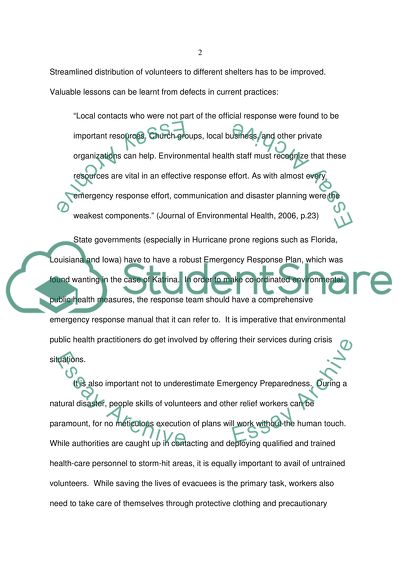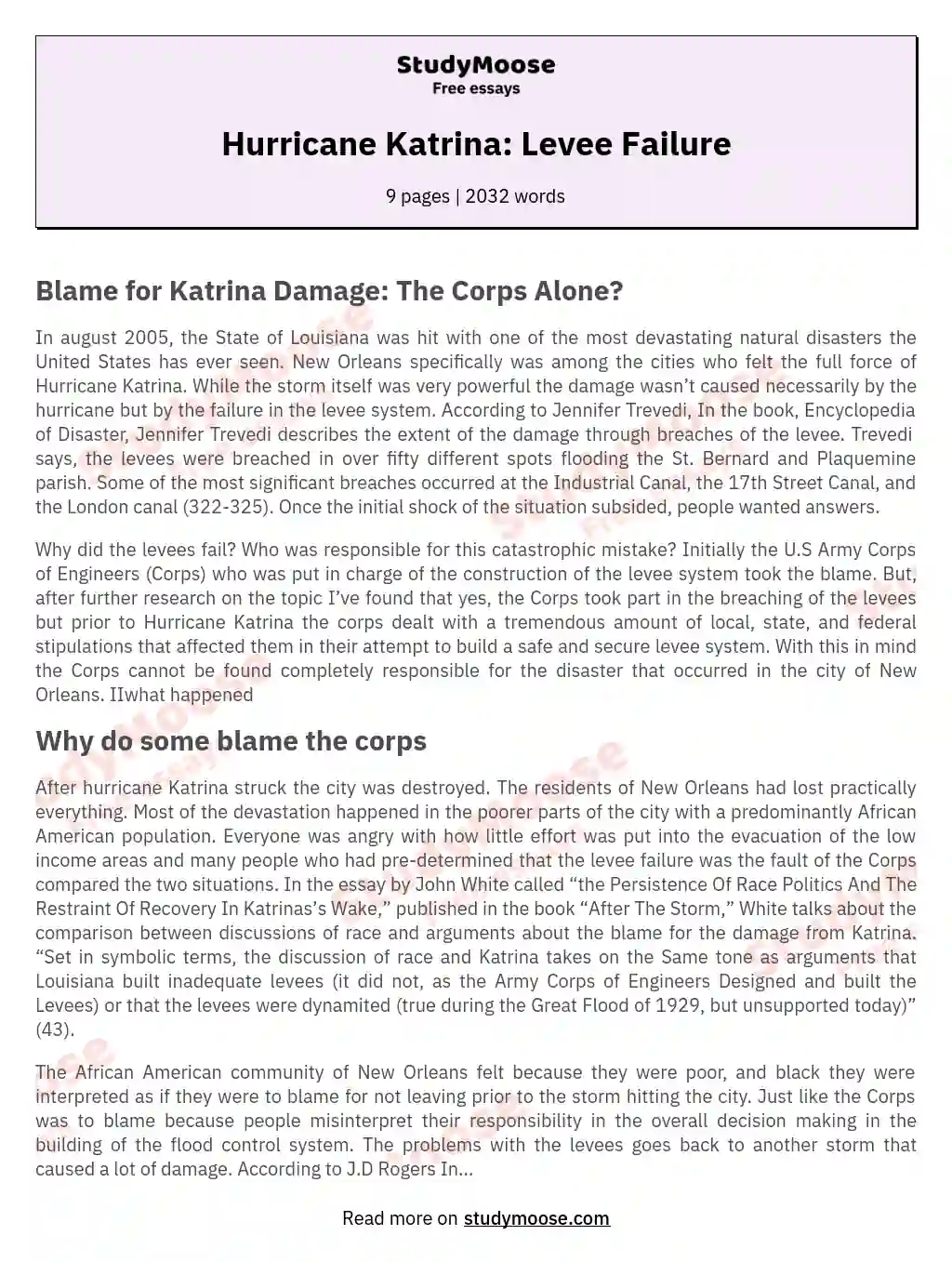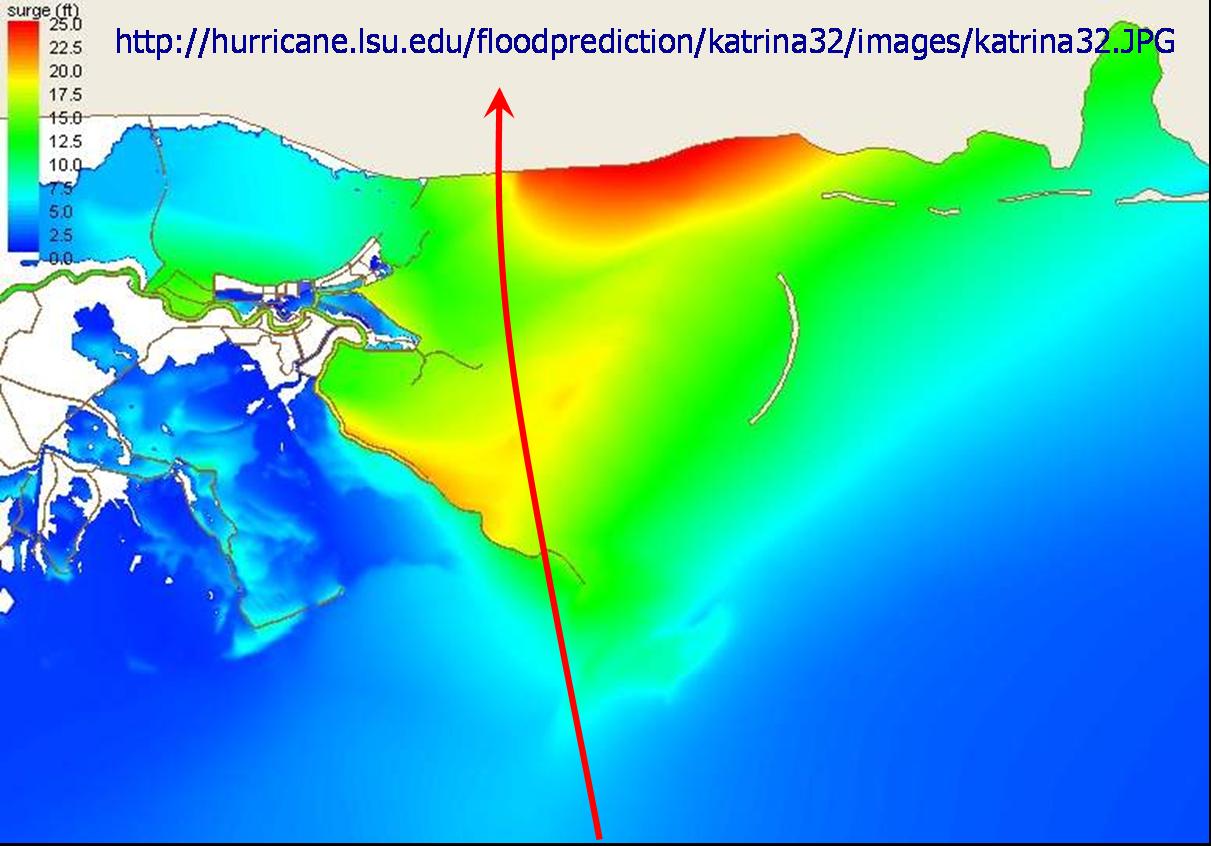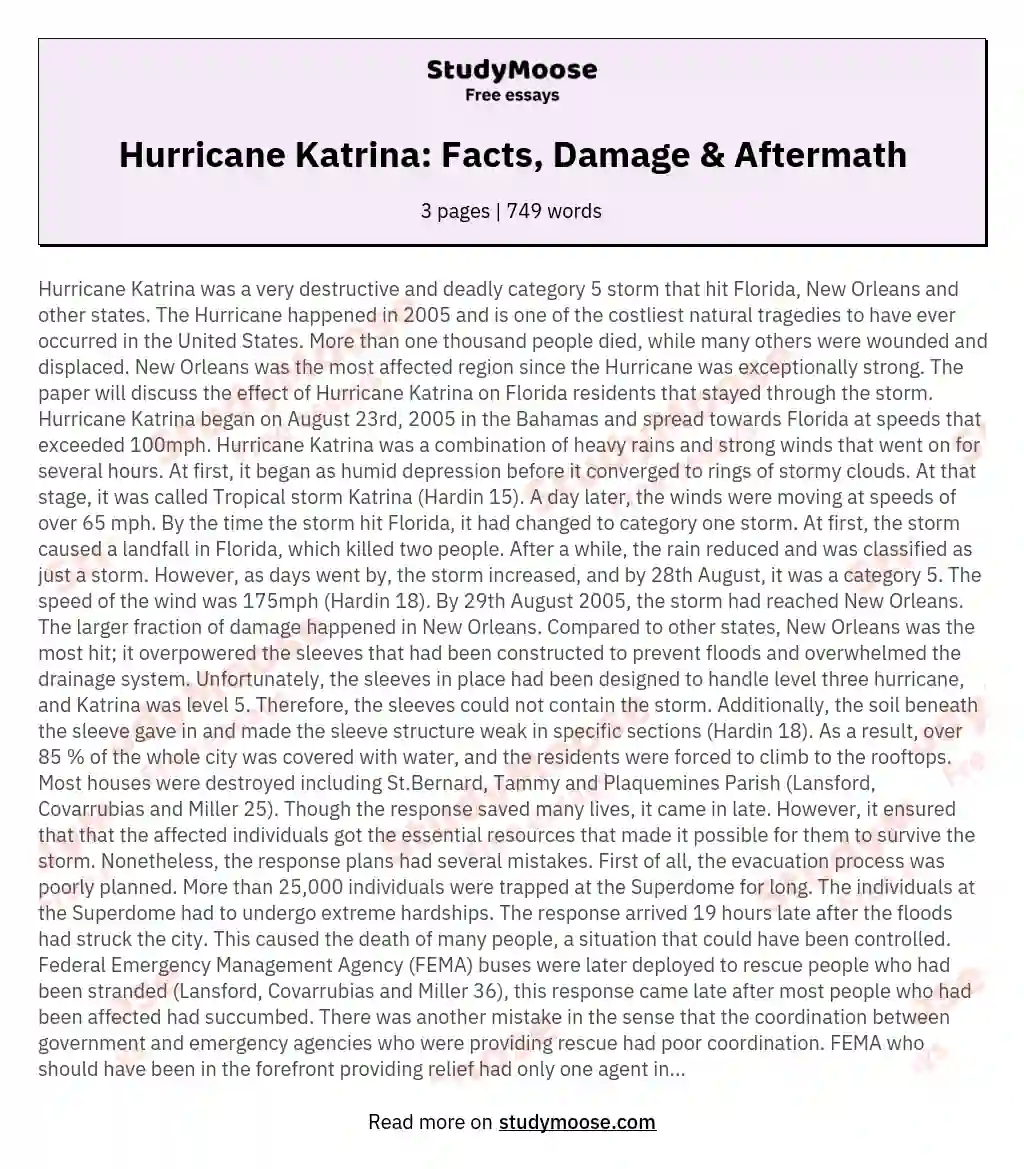Hurricane Katrina was one of the most destructive and costly natural disasters in United States history. It struck the Gulf Coast in August 2005, causing widespread damage and loss of life in Louisiana, Mississippi, and Alabama. The hurricane and its aftermath exposed vulnerabilities in the region's infrastructure, emergency response, and social fabric, and highlighted the need for better preparedness and resilience in the face of future disasters.
Katrina began as a tropical depression in the Caribbean Sea on August 23, 2005, and quickly intensified into a Category 5 hurricane as it moved northwest towards the Gulf Coast. On August 29, it made landfall near the border between Louisiana and Mississippi, with wind speeds of up to 140 mph and a storm surge of up to 28 feet. The hurricane caused widespread flooding and wind damage, destroying or damaging hundreds of thousands of homes and businesses.
One of the most catastrophic impacts of Katrina was the failure of the levee system in New Orleans. The city is located below sea level and is protected from flooding by a network of levees and floodwalls. However, the storm surge and heavy rainfall overwhelmed the system, causing several levees to break and flood more than 80% of the city. The flooding displaced hundreds of thousands of residents, many of whom were stranded in their homes or shelters without electricity, food, or clean water.
The response to the disaster was slow and inadequate, with many residents left stranded for days without help. The Federal Emergency Management Agency (FEMA) was criticized for its slow response and lack of coordination with state and local authorities. The agency was also criticized for its handling of the disaster, including its failure to provide adequate supplies and assistance to evacuees and its mismanagement of aid funds.
The aftermath of Katrina was further complicated by the issues of race and class. Many of the neighborhoods that were most heavily impacted by the storm and flooding were low-income and predominantly black. There were allegations of racial discrimination in the distribution of aid and the rebuilding efforts, with some arguing that poorer and minority communities were not given the same level of assistance as wealthier and predominantly white areas.
In the years following Katrina, the region has worked to rebuild and improve its infrastructure and emergency response systems. New Orleans has implemented a number of measures to reduce its vulnerability to future storms, including strengthening and raising its levee system and improving its emergency evacuation plans. The region has also implemented a number of initiatives to improve the resilience and preparedness of its communities, including disaster risk reduction and community-based planning efforts.
Despite these efforts, the impact of Katrina is still felt today. The storm caused an estimated $160 billion in damages and disrupted the lives of millions of people. It also exposed deep-seated issues of poverty, inequality, and social and racial injustice that continue to challenge the region. The lessons of Katrina serve as a reminder of the importance of preparedness and resilience in the face of future disasters.
Black holes are some of the most mysterious and fascinating objects in the universe. They are regions of space where the normal laws of physics break down, and where the gravitational pull is so strong that nothing, not even light, can escape from them.
Black holes can be divided into two main categories: stellar black holes and supermassive black holes. Stellar black holes are formed when a massive star collapses at the end of its life. These black holes are typically just a few times more massive than the Sun and are about the size of a city.
Supermassive black holes, on the other hand, are much larger and more massive. They can be millions or billions of times more massive than the Sun and are found at the center of most galaxies, including our own Milky Way.
Black holes are incredibly dense, with a mass packed into a small volume. This means that they have a very strong gravitational pull, which is what allows them to trap light and other matter.
One of the most interesting things about black holes is that they can be detected even though they are invisible. Scientists can infer the presence of a black hole by observing how it affects nearby objects. For example, if a black hole is located near a star, the star will be pulled towards the black hole and will speed up as it gets closer. By measuring the speed of the star and its distance from the black hole, scientists can calculate the mass of the black hole.
Black holes also emit radiation, called Hawking radiation, which is named after the physicist Stephen Hawking who first proposed the idea. This radiation is thought to be caused by the intense gravitational field of the black hole, which causes particles to be created and destroyed in pairs. One particle falls into the black hole, while the other escapes and is emitted as radiation.
There are still many mysteries surrounding black holes that scientists are trying to understand. For example, it is not yet clear how black holes are formed, or how they grow to be so massive. Additionally, there is still much to learn about the effects of black holes on the surrounding matter and how they might be used in the future.
Overall, black holes are some of the most extraordinary objects in the universe, and their study has helped us to better understand the fundamental laws of physics and the nature of the universe.
Genghis Khan was a leader who, through his military genius and leadership skills, united the nomadic tribes of Mongolia and went on to create the largest contiguous empire in history.
Born in 1162 as Temujin, Genghis Khan faced a difficult childhood marked by betrayal, hardship, and struggle. Despite these challenges, he was able to rise to power and unite the warring tribes of Mongolia through a combination of military strategy, political savvy, and charisma.
One of the key components of Genghis Khan's leadership was his ability to create and maintain a strong sense of unity among his followers. He did this by promoting a sense of shared purpose and identity among the Mongols, and by fostering a culture of loyalty and respect within his army. This unity allowed him to build a formidable fighting force that was able to conquer and control a vast territory.
In addition to his military skills, Genghis Khan was also a master diplomat and negotiator. He was able to forge alliances with other tribes and empires, and was known for his ability to mediate disputes and resolve conflicts peacefully. This helped to further strengthen his empire and expand its borders.
Despite his reputation as a ruthless conqueror, Genghis Khan was also known for his fairness and justice. He implemented a system of laws and governance that was based on merit and meritocracy, and he worked to ensure that all members of his empire were treated equally and justly.
Overall, Genghis Khan's leadership was characterized by his military genius, diplomatic skills, and commitment to justice and fairness. These qualities helped him to unite the nomadic tribes of Mongolia and create the largest contiguous empire in history, a legacy that has had a lasting impact on the world.
Hurricane Katrina was a devastating natural disaster that struck the Gulf Coast of the United States in August 2005. The hurricane, which was classified as a Category 5 storm at its peak, caused widespread destruction and loss of life in Louisiana, Mississippi, and Alabama.
The impact of Hurricane Katrina was felt far and wide, as the storm caused billions of dollars in damage and disrupted the lives of millions of people. In the aftermath of the hurricane, many residents were left without electricity, clean water, or a place to live. The storm also disrupted transportation and communication systems, making it difficult for people to get the help they needed.
One of the most significant impacts of Hurricane Katrina was the loss of life. The hurricane caused more than 1,800 deaths and left many more people injured. Many of these deaths were the result of the storm's powerful winds and the flooding that it caused. The flooding was particularly devastating, as it overwhelmed the city's levee system, causing widespread flooding and destruction.
In the aftermath of the hurricane, the federal government and aid organizations worked to provide assistance to those affected by the storm. This included providing food, water, and shelter to those who were displaced by the hurricane. It also included rebuilding efforts, such as repairing infrastructure and helping people get back on their feet.
While the response to Hurricane Katrina was not without its challenges, it ultimately demonstrated the resilience and determination of the affected communities. Despite the devastating loss and destruction, people came together to rebuild and recover from the disaster. Today, the Gulf Coast region is still recovering from the impacts of Hurricane Katrina, but it remains a testament to the strength and resilience of the human spirit.








